Health and Social Care: Communication Process Influencing Factors
VerifiedAdded on 2021/06/16
|9
|1966
|15
Report
AI Summary
This report provides a comprehensive analysis of the factors that influence the communication process within health and social care settings. It begins by highlighting the importance of effective communication in fostering positive relationships between healthcare professionals and clients, as well as among professionals. The report delves into the impact of cultural differences and values on communication styles, emphasizing how these elements shape the quality of service provided. It examines the role of legislation, charters, and codes of practice, such as the Human Rights Act, Data Protection Act, Equality Act, and various professional codes, in regulating and guiding communication practices. Furthermore, the report explores the influence of organizational systems and policies on communication strategies, including the importance of clearly defined roles, data protection, and the prevention of workplace bullying. It concludes by suggesting methods for improving the communication process, such as the implementation of active listening techniques and the use of nonverbal communication, to enhance the quality of care provided to diverse patient populations. The report stresses the need for organizations to establish policies and regulations that promote equal treatment and address cultural differences to ensure effective and ethical communication practices.
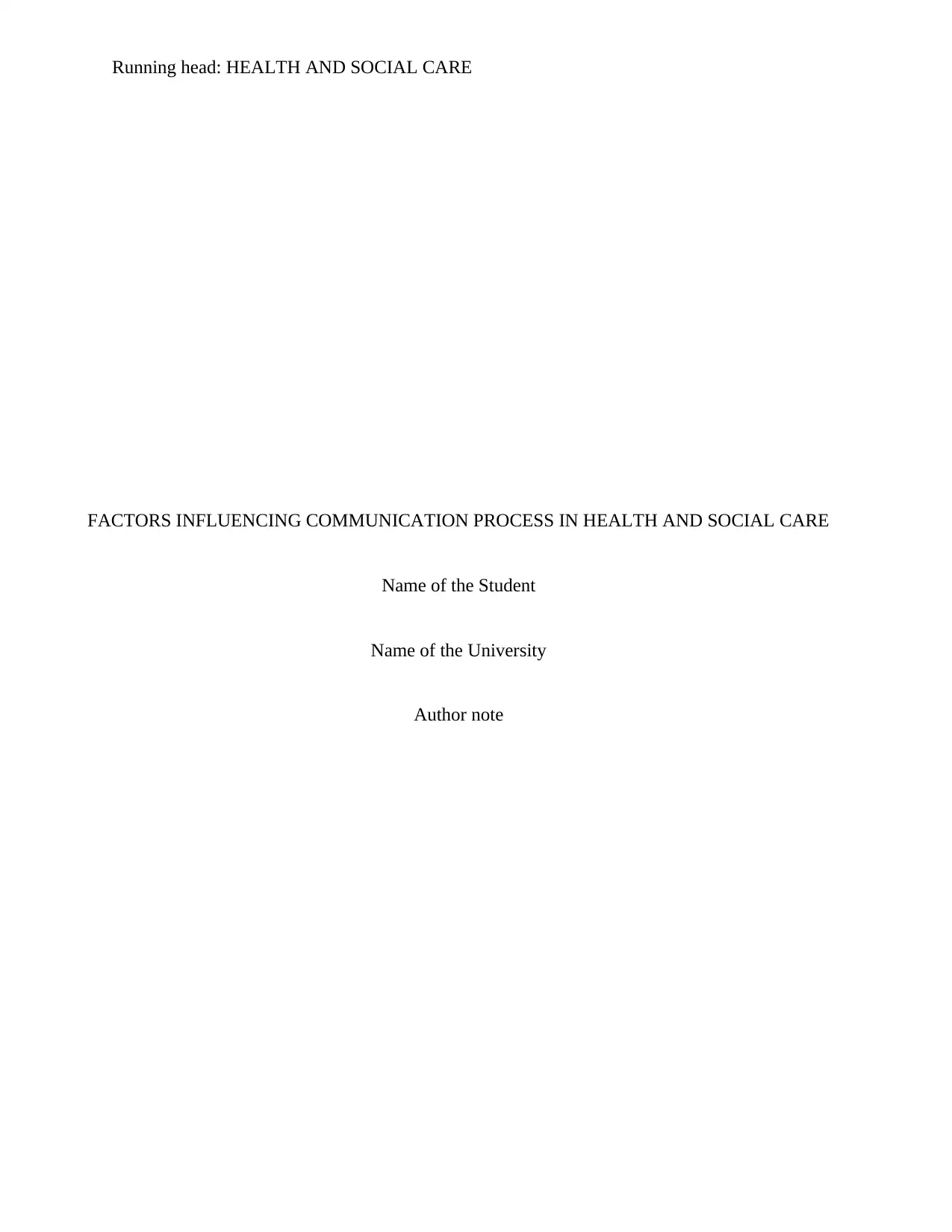
Running head: HEALTH AND SOCIAL CARE
FACTORS INFLUENCING COMMUNICATION PROCESS IN HEALTH AND SOCIAL CARE
Name of the Student
Name of the University
Author note
FACTORS INFLUENCING COMMUNICATION PROCESS IN HEALTH AND SOCIAL CARE
Name of the Student
Name of the University
Author note
Paraphrase This Document
Need a fresh take? Get an instant paraphrase of this document with our AI Paraphraser
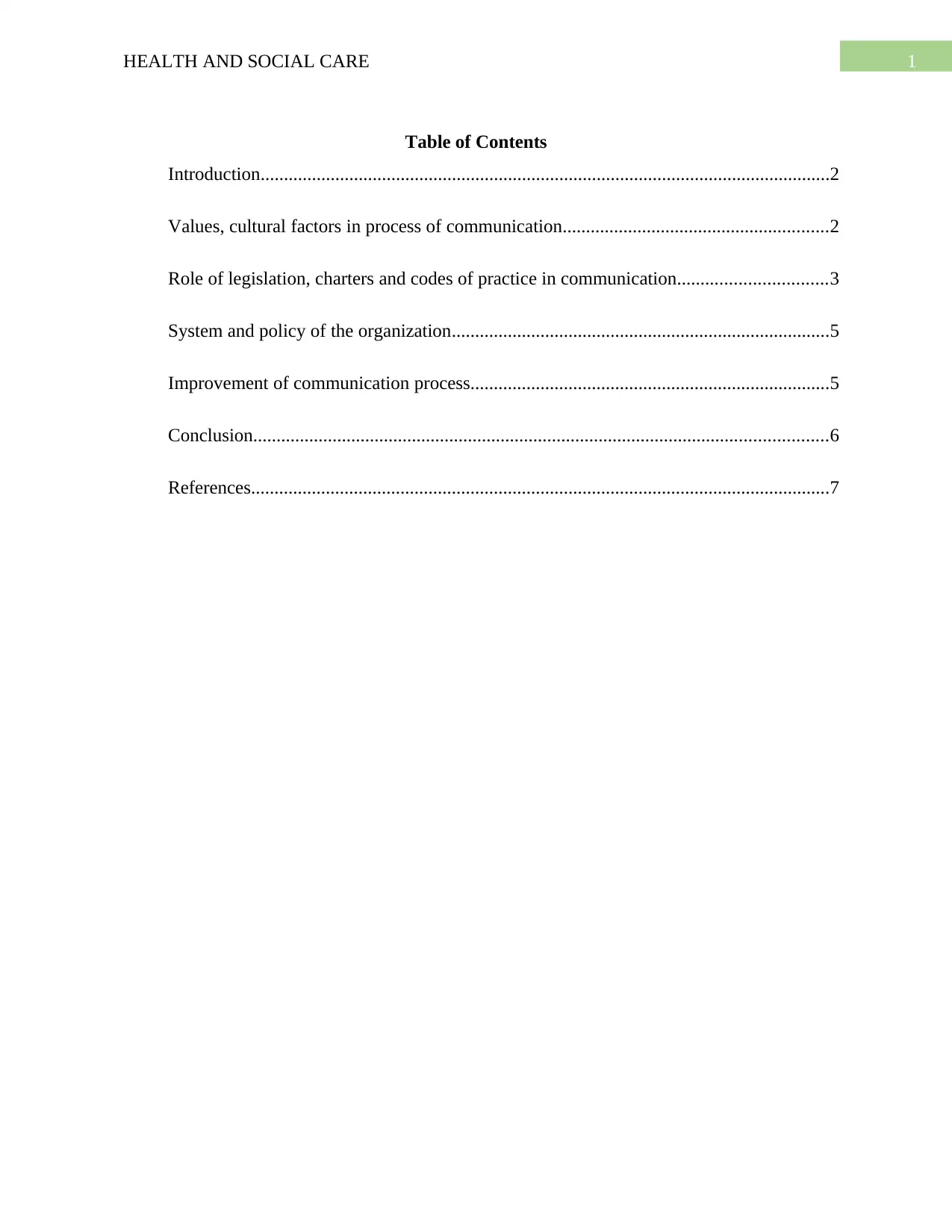
1HEALTH AND SOCIAL CARE
Table of Contents
Introduction..........................................................................................................................2
Values, cultural factors in process of communication.........................................................2
Role of legislation, charters and codes of practice in communication................................3
System and policy of the organization.................................................................................5
Improvement of communication process.............................................................................5
Conclusion...........................................................................................................................6
References............................................................................................................................7
Table of Contents
Introduction..........................................................................................................................2
Values, cultural factors in process of communication.........................................................2
Role of legislation, charters and codes of practice in communication................................3
System and policy of the organization.................................................................................5
Improvement of communication process.............................................................................5
Conclusion...........................................................................................................................6
References............................................................................................................................7
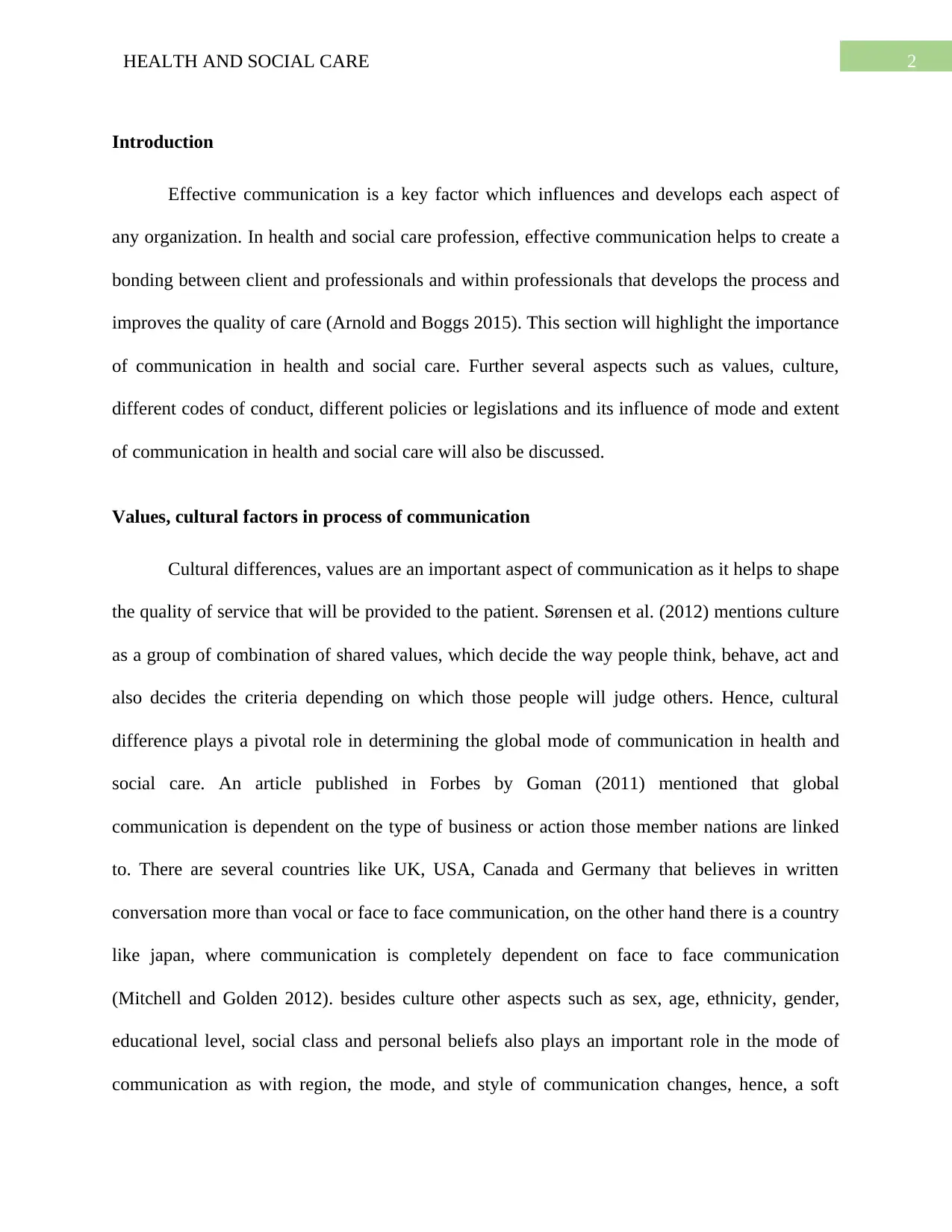
2HEALTH AND SOCIAL CARE
Introduction
Effective communication is a key factor which influences and develops each aspect of
any organization. In health and social care profession, effective communication helps to create a
bonding between client and professionals and within professionals that develops the process and
improves the quality of care (Arnold and Boggs 2015). This section will highlight the importance
of communication in health and social care. Further several aspects such as values, culture,
different codes of conduct, different policies or legislations and its influence of mode and extent
of communication in health and social care will also be discussed.
Values, cultural factors in process of communication
Cultural differences, values are an important aspect of communication as it helps to shape
the quality of service that will be provided to the patient. Sørensen et al. (2012) mentions culture
as a group of combination of shared values, which decide the way people think, behave, act and
also decides the criteria depending on which those people will judge others. Hence, cultural
difference plays a pivotal role in determining the global mode of communication in health and
social care. An article published in Forbes by Goman (2011) mentioned that global
communication is dependent on the type of business or action those member nations are linked
to. There are several countries like UK, USA, Canada and Germany that believes in written
conversation more than vocal or face to face communication, on the other hand there is a country
like japan, where communication is completely dependent on face to face communication
(Mitchell and Golden 2012). besides culture other aspects such as sex, age, ethnicity, gender,
educational level, social class and personal beliefs also plays an important role in the mode of
communication as with region, the mode, and style of communication changes, hence, a soft
Introduction
Effective communication is a key factor which influences and develops each aspect of
any organization. In health and social care profession, effective communication helps to create a
bonding between client and professionals and within professionals that develops the process and
improves the quality of care (Arnold and Boggs 2015). This section will highlight the importance
of communication in health and social care. Further several aspects such as values, culture,
different codes of conduct, different policies or legislations and its influence of mode and extent
of communication in health and social care will also be discussed.
Values, cultural factors in process of communication
Cultural differences, values are an important aspect of communication as it helps to shape
the quality of service that will be provided to the patient. Sørensen et al. (2012) mentions culture
as a group of combination of shared values, which decide the way people think, behave, act and
also decides the criteria depending on which those people will judge others. Hence, cultural
difference plays a pivotal role in determining the global mode of communication in health and
social care. An article published in Forbes by Goman (2011) mentioned that global
communication is dependent on the type of business or action those member nations are linked
to. There are several countries like UK, USA, Canada and Germany that believes in written
conversation more than vocal or face to face communication, on the other hand there is a country
like japan, where communication is completely dependent on face to face communication
(Mitchell and Golden 2012). besides culture other aspects such as sex, age, ethnicity, gender,
educational level, social class and personal beliefs also plays an important role in the mode of
communication as with region, the mode, and style of communication changes, hence, a soft
⊘ This is a preview!⊘
Do you want full access?
Subscribe today to unlock all pages.

Trusted by 1+ million students worldwide

3HEALTH AND SOCIAL CARE
communication style for one person, can seems as harsh communication method. Further, with
age, communication style also varies as a healthcare expert cannot communicate equally while
treating a child and an adult patient (pediatric and palliative). Further, depending on ethnicity,
body language, behavior and attitude determines the mode and extent of communication in
several communities (Moorhead et al. 2012).
Role of legislation, charters and codes of practice in communication
There are some conditions applied on the communication process by the legislations,
charters and code of conducts in the process of health and social care. According to Svensson
and Edström (2015), the primary legislations, controlling the mode of communication are Human
Rights act 1998, Data Protection Act 1998 and Equality Act 2001. On the other hand, three
prime charters that affect the communication process are information charter related to
department, Care Quality Communication (CQC) and voices into action. Further, there are
several codes of practice which the healthcare professionals need to follow strictly. Three
primary code of practice is present in which proper communication related guidelines has been
mentioned, these are Caldicott principles, Organizational code of practice and the Health and
Care Professions Council Standard of Proficiency for Social Workers or HCPCSPSW. In the
following section, the details of all these has been presented below
Legislations
Human rights act 1998 As the human right determines the equal
distribution of each aspect needed for a
healthy life, in makes sure that while health
receiving each patient should be treated
equally without discrimination (Cook 2012).
Data Protection Act 1998 This is a legislation which vouches for the
protection of the data and hence, as per the
legislation, the communication should be able
communication style for one person, can seems as harsh communication method. Further, with
age, communication style also varies as a healthcare expert cannot communicate equally while
treating a child and an adult patient (pediatric and palliative). Further, depending on ethnicity,
body language, behavior and attitude determines the mode and extent of communication in
several communities (Moorhead et al. 2012).
Role of legislation, charters and codes of practice in communication
There are some conditions applied on the communication process by the legislations,
charters and code of conducts in the process of health and social care. According to Svensson
and Edström (2015), the primary legislations, controlling the mode of communication are Human
Rights act 1998, Data Protection Act 1998 and Equality Act 2001. On the other hand, three
prime charters that affect the communication process are information charter related to
department, Care Quality Communication (CQC) and voices into action. Further, there are
several codes of practice which the healthcare professionals need to follow strictly. Three
primary code of practice is present in which proper communication related guidelines has been
mentioned, these are Caldicott principles, Organizational code of practice and the Health and
Care Professions Council Standard of Proficiency for Social Workers or HCPCSPSW. In the
following section, the details of all these has been presented below
Legislations
Human rights act 1998 As the human right determines the equal
distribution of each aspect needed for a
healthy life, in makes sure that while health
receiving each patient should be treated
equally without discrimination (Cook 2012).
Data Protection Act 1998 This is a legislation which vouches for the
protection of the data and hence, as per the
legislation, the communication should be able
Paraphrase This Document
Need a fresh take? Get an instant paraphrase of this document with our AI Paraphraser
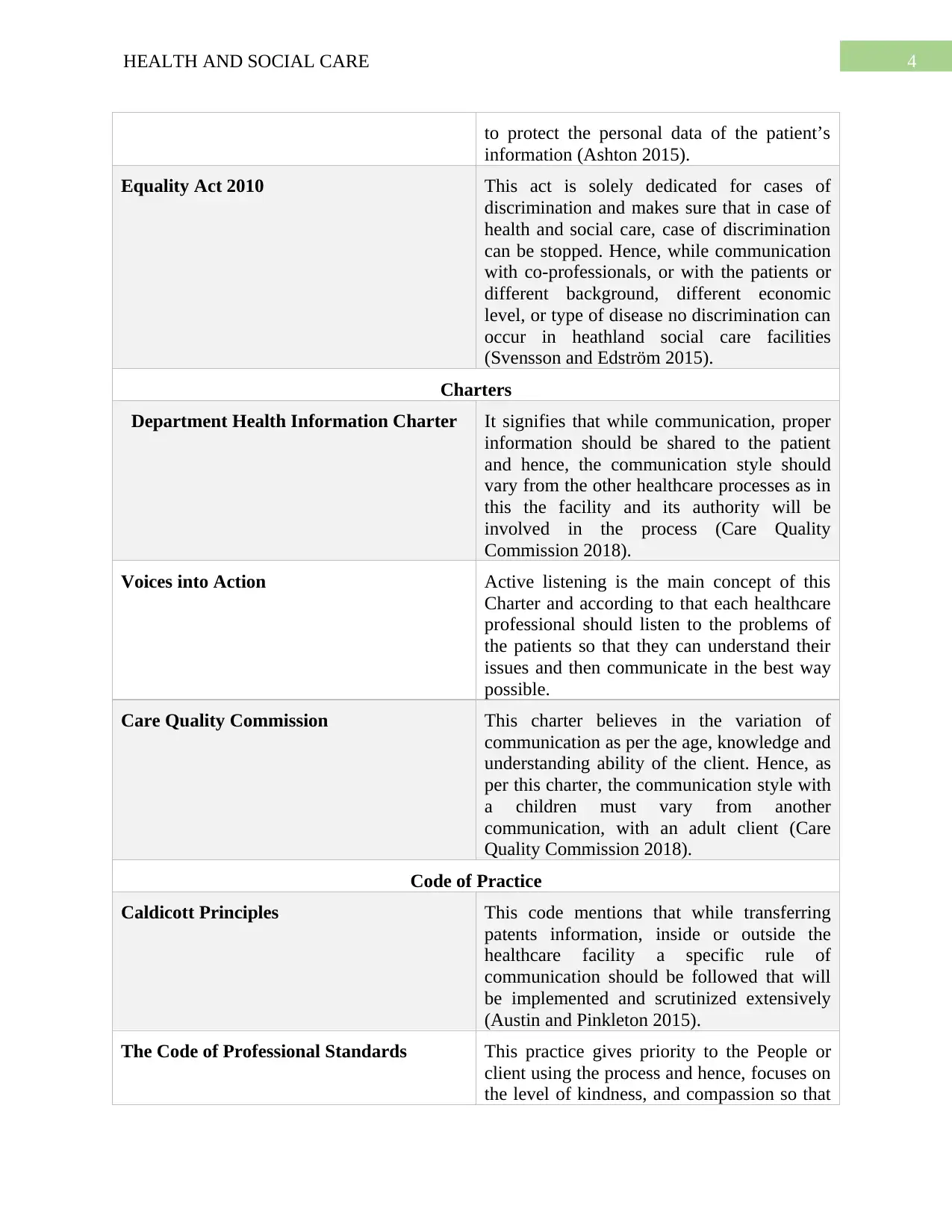
4HEALTH AND SOCIAL CARE
to protect the personal data of the patient’s
information (Ashton 2015).
Equality Act 2010 This act is solely dedicated for cases of
discrimination and makes sure that in case of
health and social care, case of discrimination
can be stopped. Hence, while communication
with co-professionals, or with the patients or
different background, different economic
level, or type of disease no discrimination can
occur in heathland social care facilities
(Svensson and Edström 2015).
Charters
Department Health Information Charter It signifies that while communication, proper
information should be shared to the patient
and hence, the communication style should
vary from the other healthcare processes as in
this the facility and its authority will be
involved in the process (Care Quality
Commission 2018).
Voices into Action Active listening is the main concept of this
Charter and according to that each healthcare
professional should listen to the problems of
the patients so that they can understand their
issues and then communicate in the best way
possible.
Care Quality Commission This charter believes in the variation of
communication as per the age, knowledge and
understanding ability of the client. Hence, as
per this charter, the communication style with
a children must vary from another
communication, with an adult client (Care
Quality Commission 2018).
Code of Practice
Caldicott Principles This code mentions that while transferring
patents information, inside or outside the
healthcare facility a specific rule of
communication should be followed that will
be implemented and scrutinized extensively
(Austin and Pinkleton 2015).
The Code of Professional Standards This practice gives priority to the People or
client using the process and hence, focuses on
the level of kindness, and compassion so that
to protect the personal data of the patient’s
information (Ashton 2015).
Equality Act 2010 This act is solely dedicated for cases of
discrimination and makes sure that in case of
health and social care, case of discrimination
can be stopped. Hence, while communication
with co-professionals, or with the patients or
different background, different economic
level, or type of disease no discrimination can
occur in heathland social care facilities
(Svensson and Edström 2015).
Charters
Department Health Information Charter It signifies that while communication, proper
information should be shared to the patient
and hence, the communication style should
vary from the other healthcare processes as in
this the facility and its authority will be
involved in the process (Care Quality
Commission 2018).
Voices into Action Active listening is the main concept of this
Charter and according to that each healthcare
professional should listen to the problems of
the patients so that they can understand their
issues and then communicate in the best way
possible.
Care Quality Commission This charter believes in the variation of
communication as per the age, knowledge and
understanding ability of the client. Hence, as
per this charter, the communication style with
a children must vary from another
communication, with an adult client (Care
Quality Commission 2018).
Code of Practice
Caldicott Principles This code mentions that while transferring
patents information, inside or outside the
healthcare facility a specific rule of
communication should be followed that will
be implemented and scrutinized extensively
(Austin and Pinkleton 2015).
The Code of Professional Standards This practice gives priority to the People or
client using the process and hence, focuses on
the level of kindness, and compassion so that
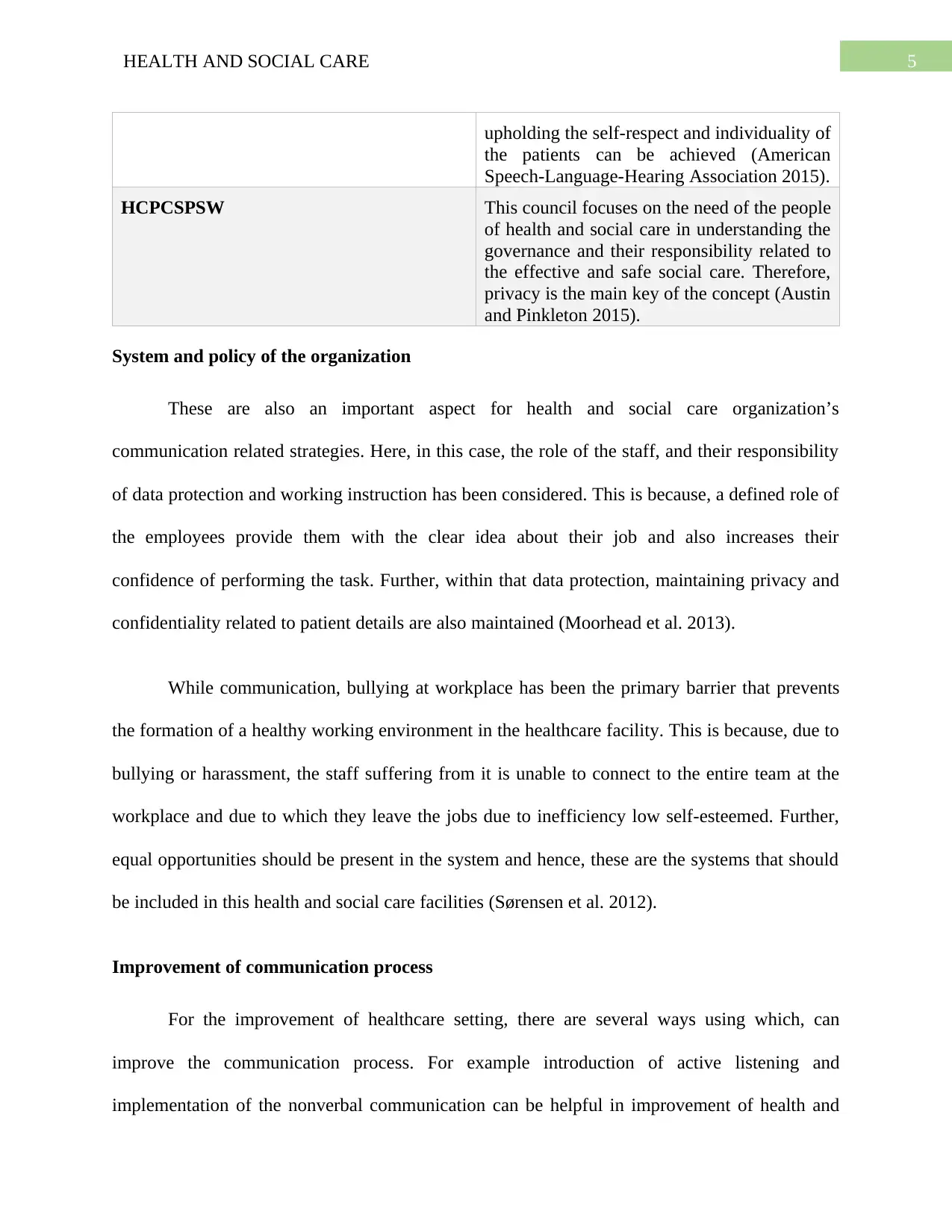
5HEALTH AND SOCIAL CARE
upholding the self-respect and individuality of
the patients can be achieved (American
Speech-Language-Hearing Association 2015).
HCPCSPSW This council focuses on the need of the people
of health and social care in understanding the
governance and their responsibility related to
the effective and safe social care. Therefore,
privacy is the main key of the concept (Austin
and Pinkleton 2015).
System and policy of the organization
These are also an important aspect for health and social care organization’s
communication related strategies. Here, in this case, the role of the staff, and their responsibility
of data protection and working instruction has been considered. This is because, a defined role of
the employees provide them with the clear idea about their job and also increases their
confidence of performing the task. Further, within that data protection, maintaining privacy and
confidentiality related to patient details are also maintained (Moorhead et al. 2013).
While communication, bullying at workplace has been the primary barrier that prevents
the formation of a healthy working environment in the healthcare facility. This is because, due to
bullying or harassment, the staff suffering from it is unable to connect to the entire team at the
workplace and due to which they leave the jobs due to inefficiency low self-esteemed. Further,
equal opportunities should be present in the system and hence, these are the systems that should
be included in this health and social care facilities (Sørensen et al. 2012).
Improvement of communication process
For the improvement of healthcare setting, there are several ways using which, can
improve the communication process. For example introduction of active listening and
implementation of the nonverbal communication can be helpful in improvement of health and
upholding the self-respect and individuality of
the patients can be achieved (American
Speech-Language-Hearing Association 2015).
HCPCSPSW This council focuses on the need of the people
of health and social care in understanding the
governance and their responsibility related to
the effective and safe social care. Therefore,
privacy is the main key of the concept (Austin
and Pinkleton 2015).
System and policy of the organization
These are also an important aspect for health and social care organization’s
communication related strategies. Here, in this case, the role of the staff, and their responsibility
of data protection and working instruction has been considered. This is because, a defined role of
the employees provide them with the clear idea about their job and also increases their
confidence of performing the task. Further, within that data protection, maintaining privacy and
confidentiality related to patient details are also maintained (Moorhead et al. 2013).
While communication, bullying at workplace has been the primary barrier that prevents
the formation of a healthy working environment in the healthcare facility. This is because, due to
bullying or harassment, the staff suffering from it is unable to connect to the entire team at the
workplace and due to which they leave the jobs due to inefficiency low self-esteemed. Further,
equal opportunities should be present in the system and hence, these are the systems that should
be included in this health and social care facilities (Sørensen et al. 2012).
Improvement of communication process
For the improvement of healthcare setting, there are several ways using which, can
improve the communication process. For example introduction of active listening and
implementation of the nonverbal communication can be helpful in improvement of health and
⊘ This is a preview!⊘
Do you want full access?
Subscribe today to unlock all pages.

Trusted by 1+ million students worldwide
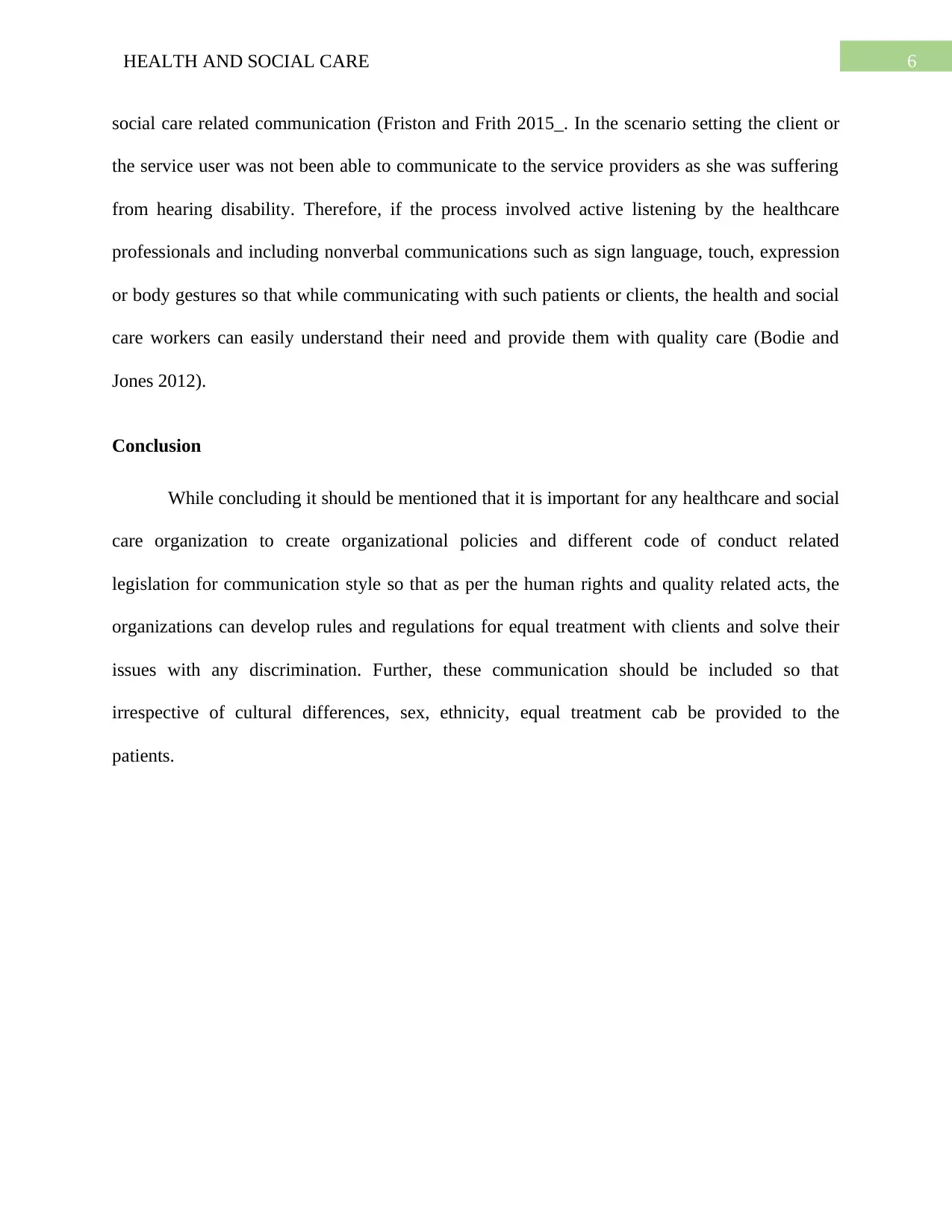
6HEALTH AND SOCIAL CARE
social care related communication (Friston and Frith 2015_. In the scenario setting the client or
the service user was not been able to communicate to the service providers as she was suffering
from hearing disability. Therefore, if the process involved active listening by the healthcare
professionals and including nonverbal communications such as sign language, touch, expression
or body gestures so that while communicating with such patients or clients, the health and social
care workers can easily understand their need and provide them with quality care (Bodie and
Jones 2012).
Conclusion
While concluding it should be mentioned that it is important for any healthcare and social
care organization to create organizational policies and different code of conduct related
legislation for communication style so that as per the human rights and quality related acts, the
organizations can develop rules and regulations for equal treatment with clients and solve their
issues with any discrimination. Further, these communication should be included so that
irrespective of cultural differences, sex, ethnicity, equal treatment cab be provided to the
patients.
social care related communication (Friston and Frith 2015_. In the scenario setting the client or
the service user was not been able to communicate to the service providers as she was suffering
from hearing disability. Therefore, if the process involved active listening by the healthcare
professionals and including nonverbal communications such as sign language, touch, expression
or body gestures so that while communicating with such patients or clients, the health and social
care workers can easily understand their need and provide them with quality care (Bodie and
Jones 2012).
Conclusion
While concluding it should be mentioned that it is important for any healthcare and social
care organization to create organizational policies and different code of conduct related
legislation for communication style so that as per the human rights and quality related acts, the
organizations can develop rules and regulations for equal treatment with clients and solve their
issues with any discrimination. Further, these communication should be included so that
irrespective of cultural differences, sex, ethnicity, equal treatment cab be provided to the
patients.
Paraphrase This Document
Need a fresh take? Get an instant paraphrase of this document with our AI Paraphraser
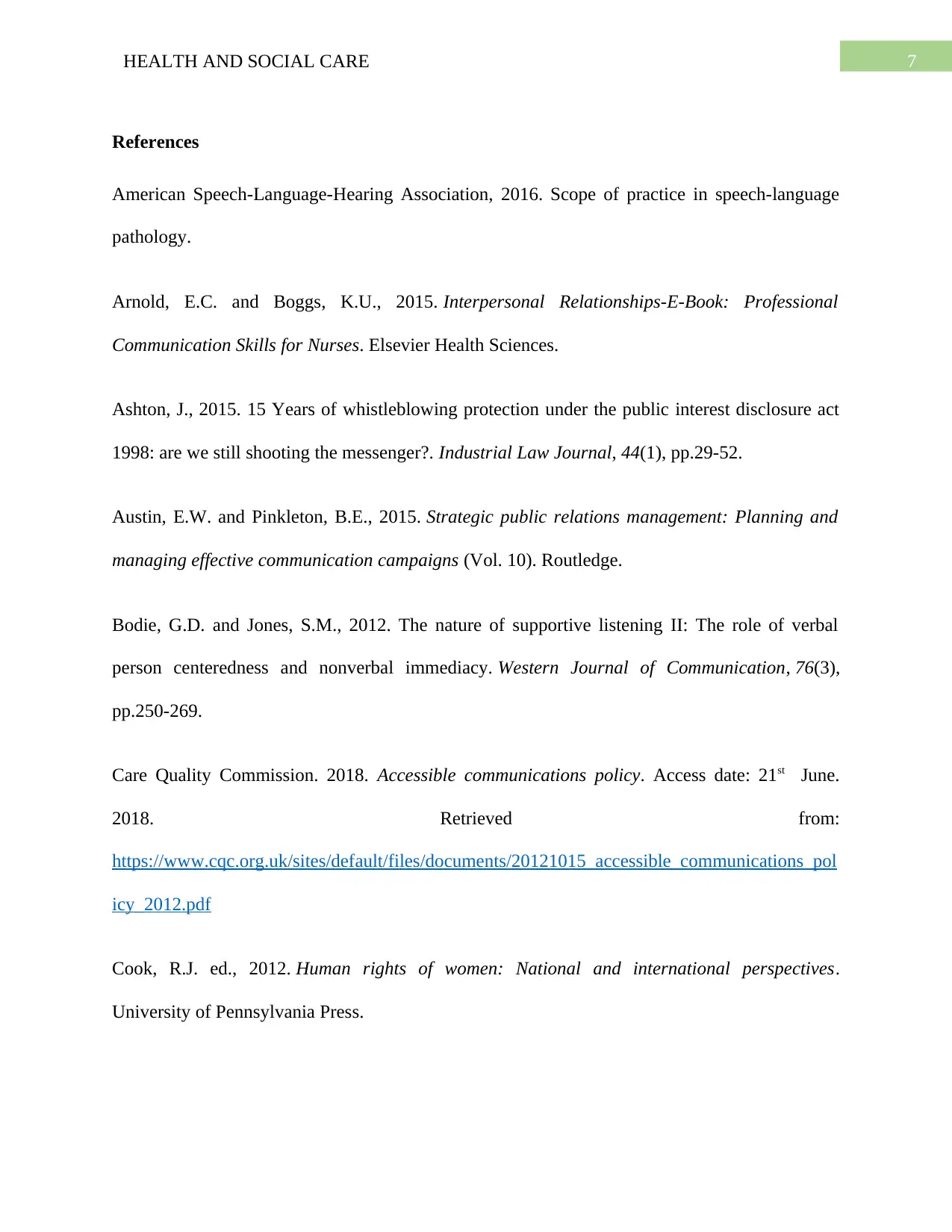
7HEALTH AND SOCIAL CARE
References
American Speech-Language-Hearing Association, 2016. Scope of practice in speech-language
pathology.
Arnold, E.C. and Boggs, K.U., 2015. Interpersonal Relationships-E-Book: Professional
Communication Skills for Nurses. Elsevier Health Sciences.
Ashton, J., 2015. 15 Years of whistleblowing protection under the public interest disclosure act
1998: are we still shooting the messenger?. Industrial Law Journal, 44(1), pp.29-52.
Austin, E.W. and Pinkleton, B.E., 2015. Strategic public relations management: Planning and
managing effective communication campaigns (Vol. 10). Routledge.
Bodie, G.D. and Jones, S.M., 2012. The nature of supportive listening II: The role of verbal
person centeredness and nonverbal immediacy. Western Journal of Communication, 76(3),
pp.250-269.
Care Quality Commission. 2018. Accessible communications policy. Access date: 21st June.
2018. Retrieved from:
https://www.cqc.org.uk/sites/default/files/documents/20121015_accessible_communications_pol
icy_2012.pdf
Cook, R.J. ed., 2012. Human rights of women: National and international perspectives.
University of Pennsylvania Press.
References
American Speech-Language-Hearing Association, 2016. Scope of practice in speech-language
pathology.
Arnold, E.C. and Boggs, K.U., 2015. Interpersonal Relationships-E-Book: Professional
Communication Skills for Nurses. Elsevier Health Sciences.
Ashton, J., 2015. 15 Years of whistleblowing protection under the public interest disclosure act
1998: are we still shooting the messenger?. Industrial Law Journal, 44(1), pp.29-52.
Austin, E.W. and Pinkleton, B.E., 2015. Strategic public relations management: Planning and
managing effective communication campaigns (Vol. 10). Routledge.
Bodie, G.D. and Jones, S.M., 2012. The nature of supportive listening II: The role of verbal
person centeredness and nonverbal immediacy. Western Journal of Communication, 76(3),
pp.250-269.
Care Quality Commission. 2018. Accessible communications policy. Access date: 21st June.
2018. Retrieved from:
https://www.cqc.org.uk/sites/default/files/documents/20121015_accessible_communications_pol
icy_2012.pdf
Cook, R.J. ed., 2012. Human rights of women: National and international perspectives.
University of Pennsylvania Press.
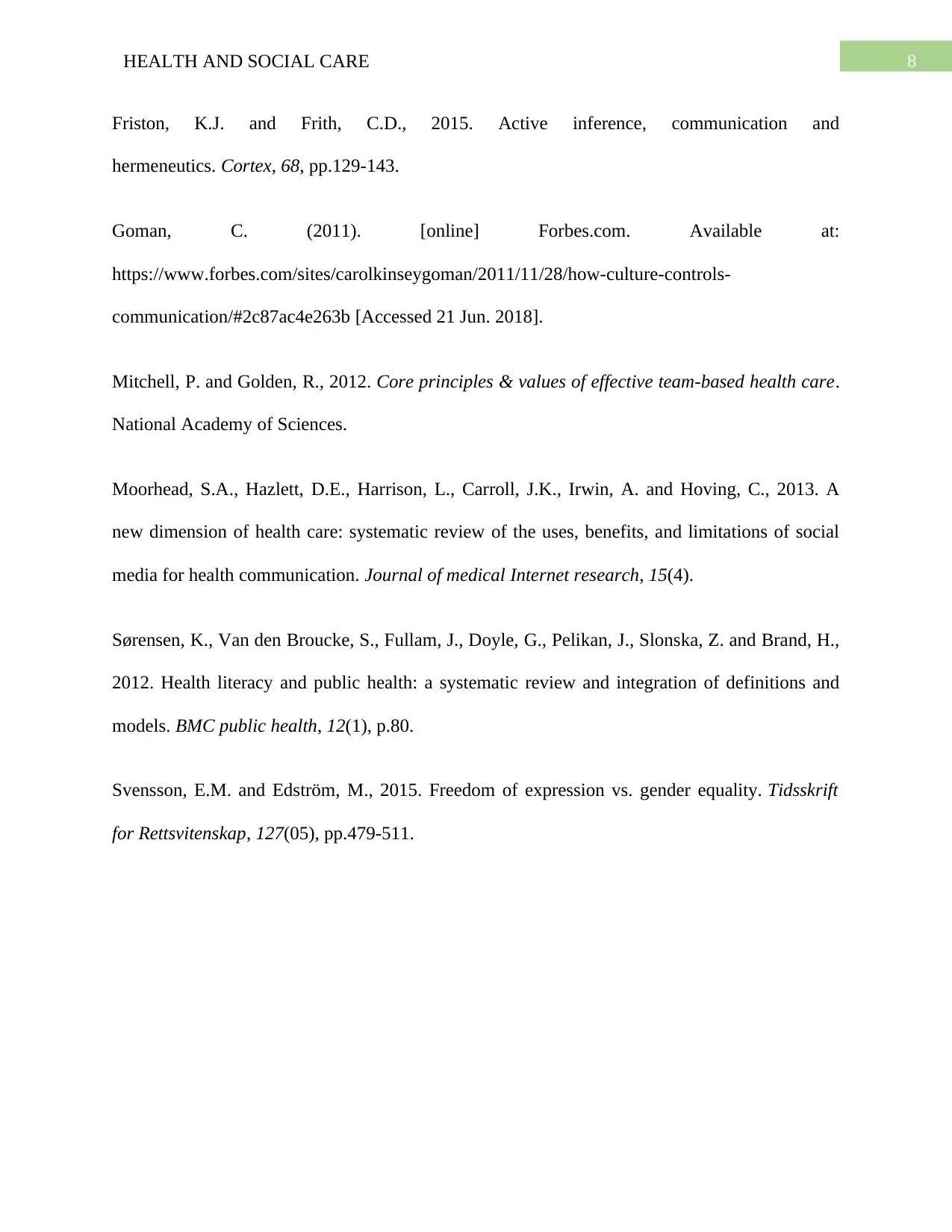
8HEALTH AND SOCIAL CARE
Friston, K.J. and Frith, C.D., 2015. Active inference, communication and
hermeneutics. Cortex, 68, pp.129-143.
Goman, C. (2011). [online] Forbes.com. Available at:
https://www.forbes.com/sites/carolkinseygoman/2011/11/28/how-culture-controls-
communication/#2c87ac4e263b [Accessed 21 Jun. 2018].
Mitchell, P. and Golden, R., 2012. Core principles & values of effective team-based health care.
National Academy of Sciences.
Moorhead, S.A., Hazlett, D.E., Harrison, L., Carroll, J.K., Irwin, A. and Hoving, C., 2013. A
new dimension of health care: systematic review of the uses, benefits, and limitations of social
media for health communication. Journal of medical Internet research, 15(4).
Sørensen, K., Van den Broucke, S., Fullam, J., Doyle, G., Pelikan, J., Slonska, Z. and Brand, H.,
2012. Health literacy and public health: a systematic review and integration of definitions and
models. BMC public health, 12(1), p.80.
Svensson, E.M. and Edström, M., 2015. Freedom of expression vs. gender equality. Tidsskrift
for Rettsvitenskap, 127(05), pp.479-511.
Friston, K.J. and Frith, C.D., 2015. Active inference, communication and
hermeneutics. Cortex, 68, pp.129-143.
Goman, C. (2011). [online] Forbes.com. Available at:
https://www.forbes.com/sites/carolkinseygoman/2011/11/28/how-culture-controls-
communication/#2c87ac4e263b [Accessed 21 Jun. 2018].
Mitchell, P. and Golden, R., 2012. Core principles & values of effective team-based health care.
National Academy of Sciences.
Moorhead, S.A., Hazlett, D.E., Harrison, L., Carroll, J.K., Irwin, A. and Hoving, C., 2013. A
new dimension of health care: systematic review of the uses, benefits, and limitations of social
media for health communication. Journal of medical Internet research, 15(4).
Sørensen, K., Van den Broucke, S., Fullam, J., Doyle, G., Pelikan, J., Slonska, Z. and Brand, H.,
2012. Health literacy and public health: a systematic review and integration of definitions and
models. BMC public health, 12(1), p.80.
Svensson, E.M. and Edström, M., 2015. Freedom of expression vs. gender equality. Tidsskrift
for Rettsvitenskap, 127(05), pp.479-511.
⊘ This is a preview!⊘
Do you want full access?
Subscribe today to unlock all pages.

Trusted by 1+ million students worldwide
1 out of 9
Related Documents
Your All-in-One AI-Powered Toolkit for Academic Success.
+13062052269
info@desklib.com
Available 24*7 on WhatsApp / Email
![[object Object]](/_next/static/media/star-bottom.7253800d.svg)
Unlock your academic potential
Copyright © 2020–2025 A2Z Services. All Rights Reserved. Developed and managed by ZUCOL.





